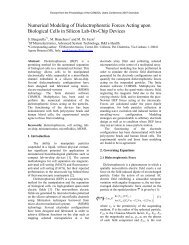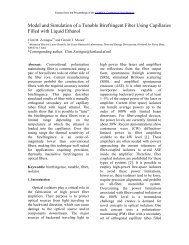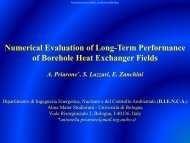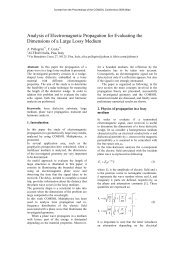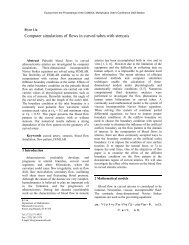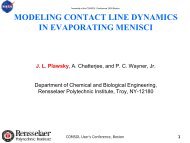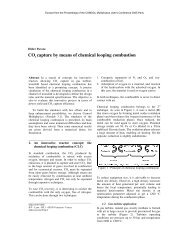Design of high pressure processing vessel - COMSOL.com
Design of high pressure processing vessel - COMSOL.com
Design of high pressure processing vessel - COMSOL.com
- No tags were found...
You also want an ePaper? Increase the reach of your titles
YUMPU automatically turns print PDFs into web optimized ePapers that Google loves.
Modeling <strong>of</strong> Pressure Pr<strong>of</strong>iles in aHigh Pressure Chamber using<strong>COMSOL</strong> MultiphysicsPresented at <strong>COMSOL</strong> Conference 2012 BangaloreDr. P. Srinivasa Rao &Chamanooru Kartik ChandraIndian Institute <strong>of</strong> Technology Kharagpur
Points to be covered‣Introduction‣Significance <strong>of</strong> HPP system‣<strong>Design</strong> requirements for HPP system‣<strong>Design</strong> <strong>of</strong> cylindrical shell‣Modelling <strong>of</strong> cylindrical shell using <strong>COMSOL</strong>
Introduction• Conventional food sterilization andpreservation methods <strong>of</strong>ten result in anumber <strong>of</strong> undesired changes in foods.• HPP is a non-thermal food <strong>processing</strong> method• It subjects liquid or solid foods, with orwithout packaging, to <strong>pressure</strong>s between 50and 1000 MPa.
Introduction• HP Processing has potential to replaceconventional heat induced sterilization andpasteurization processes.• Need to develop and produce HPP equipmentfor Indian food <strong>processing</strong> sector
PROCESS DESCRIPTION• In a HP process, the food product to be treated is placedin a <strong>pressure</strong> <strong>vessel</strong> capable <strong>of</strong> sustaining the required<strong>pressure</strong> (50-1000 MPa); the product is submerged in aliquid, which acts as the <strong>pressure</strong>-transmitting medium.• Some <strong>pressure</strong> transmitting media used in a HP chamberinclude water, castor oil, silicone oil, sodium benzoate,ethanol and glycol.• Industrial High Pressure systems<strong>processing</strong> systems.are usually batch• The selection <strong>of</strong> equipment depends on the kind <strong>of</strong> foodproduct to be processed.• Solid food products or foods with large solid particles canonly be treated in a batch mode.
PROCESS DESCRIPTION• Liquids, slurries and other pumpable products have theadditional option <strong>of</strong> semi-continuous production• If water is used as the pressurizing medium, its<strong>com</strong>pressibility must be accounted for; water is<strong>com</strong>pressed by up to15 per cent <strong>of</strong> volume at <strong>pressure</strong>sabove 600 MPa.• Once the desired <strong>pressure</strong> is reached, the pump orpiston is stopped, the valves are closed and the<strong>pressure</strong> is maintained without further energy input.• After the required hold time has elapsed, the system isdepressurized, the <strong>vessel</strong> opened and the productunloaded.
Significance• Despite <strong>of</strong> many advantages, cost <strong>of</strong> <strong>high</strong><strong>pressure</strong> <strong>processing</strong> is <strong>high</strong>, mainly due to cost<strong>of</strong> HPP equipment.• Import from overseas.• This is an attempt to design an indigenous<strong>high</strong> <strong>pressure</strong> <strong>processing</strong> <strong>vessel</strong> which is heart<strong>of</strong> HPP equipment.
HPP equipment - <strong>com</strong>ponents• Pressure <strong>vessel</strong>‣Cylindrical shell‣Removable Head (cap)‣Nozzle‣Pressurization and de<strong>com</strong>pression valves• Vessel supports• High <strong>pressure</strong> pump• Cooling / heating arrangement• Temperature, <strong>pressure</strong> sensors• Control unit
ASME Codes• The organization is known for setting codesand standards for mechanical devices• Adopted worldwide for design and fabrication<strong>of</strong> <strong>pressure</strong> <strong>vessel</strong>s• For design and construction <strong>of</strong> boiler and<strong>pressure</strong> <strong>vessel</strong>s - ASME section VIII, division 1and division 2
1. Maximum stress theory• Both ASME Code Section VIII Division 1, andSection I use the maximum stress theory as abasis for design.• The maximum principal stress is determinedapplying this theory
2. Maximum Shear Stress Theory• Yielding will start at a point when themaximum shear stress at that point reachesone-half <strong>of</strong> the the uniaxial yield strength.• Both ASME Code, Section VIII, Division 2 andASME Code, Section III, utilize the maximumshear stress criterion.
Lames equationCircumferential stress,Radial stress,Longitudinal stress,
Fig. 1 Hoop and radialstresses in cylindrical shellFig. 2 Hoop and radialstress distribution incylindrical shell
Factor <strong>of</strong> safety• Uncertainties in load, the dimensions, and thematerial properties.• 62.5 percent <strong>of</strong> the yield strength at designtemperature• European <strong>pressure</strong> <strong>vessel</strong> construction codestypically employ a factor <strong>of</strong> safety <strong>of</strong> 1.5 forthe yield strength for a simple environment .
<strong>Design</strong> requirements• Operating <strong>pressure</strong> = 500 MPa• Capacity = 0.5 litre• Temperature range : 10 to 100 0 C• Loading – unloading : Manual• Indirect <strong>com</strong>pression• Batch type processFor 10 cm depth <strong>of</strong> the <strong>vessel</strong>, inside diameter <strong>of</strong> the<strong>vessel</strong> will be 8 cm.
<strong>Design</strong> <strong>of</strong> cylindrical shell• Using ASME codes and Lames equation forcalculation <strong>of</strong> principle stresses.Sr. No. Thickness (m)σlong (MPa) σrad (MPa) σhoop (MPa)at r iat r o1 0.04(r o = 0.08)2 0.06( r o = 0.1)3 0.08( r o = 0.12)4 0.1( r o = 0.14)5 0.11( r o = 0.15)166.667 500 833.33 333.3395.2381 500 690.4762 190.476262.5 500 624.994 124.99944.444 500 588.889 88.88938.2775 500 576.55 76.55
Dimensions <strong>of</strong> cylindrical shellInside diameter (Di)ThicknessOutside diameter (Do)Depth <strong>of</strong> shell (l)0.08 m0.11 m0.3 m0.1 mConsidering factor <strong>of</strong> safety <strong>of</strong> 1.5, required minimum yieldstrength <strong>of</strong> material to be selected should be 895 MPa
Slotted cylinder arrangement
<strong>COMSOL</strong> multiphysics• Three dimensional finite-element analysiss<strong>of</strong>tware which uses solid elements foranalysis.• Import facilities for solid elements• Different possible failures• Accurate design assessment
METHODOLOGY An FEM analysis <strong>of</strong> a hollow cylinder, and the <strong>pressure</strong><strong>vessel</strong> used for HPP was performed. Surface von Mises stresses were first modelled, after whichthermal stresses arising from the cylinder not being free toexpand and contrast to changes to temperature weremodelled together with the von Mises stress. Considering the <strong>com</strong>pressive medium to be a fluid at 70 °C,the changes in the temperature <strong>of</strong> the <strong>vessel</strong> with time wasmodelled. A general <strong>pressure</strong> <strong>vessel</strong> has an inlet at its bottom surfacefor the working fluid to enter the chamber. The top <strong>of</strong> the <strong>vessel</strong> has constrictions for the top cap toenter and lock into the constrictions. 5 constrictions havebeen placed on the <strong>vessel</strong> designed in this case..
Stress distribution in cylindrical shell
Stress distribution in cylindrical shell
Stress in Screwed cylinder arrangement
Pressure Vessel (empty) – Geometry, Loading pr<strong>of</strong>ile and fixed constraintsMesh and MeshStatistics
Stress Pr<strong>of</strong>ile – EmptyPressure VesselStress Pr<strong>of</strong>ile – EmptyPressure VesselInternalPressure(MPa)Maximumvon MisesStress(MPa)200 358.21250 447.77300 606.4350 626.9400 716.47450 806.03500 895.61
Empty Pressure Vessel – Pressure vs. Stress plot• In the case <strong>of</strong> empty <strong>pressure</strong> <strong>vessel</strong>, the plot between the internallyapplied <strong>pressure</strong> and the maximum von Mises stress has been found to beessentially a linear plot. This is in accordance with the theoretical findings<strong>of</strong> the plot in case <strong>of</strong> a cylinder under loading.• The linear increase is attributed to the fact that the amount <strong>of</strong> expansiveforce on the surface has been increased leading to an increase in theprincipal stresses in the walls and consequently, in the magnitude <strong>of</strong> the vonMises stress.• The linear increase results from the fact that within elastic range, therelation between <strong>pressure</strong> applied or stress applied results in a linearvariation <strong>of</strong> the strain produced in the <strong>vessel</strong>, in accordance to the Young’srelationship between stress and strain.
Pressure Vessel with polyethylene coreMesh generated
Pressure Vessel withpolyethylene core – LoadingPr<strong>of</strong>ile• The loading surfaces in the <strong>pressure</strong> <strong>vessel</strong> are theinterior surfaces <strong>of</strong> the <strong>vessel</strong> and the outer surfaces <strong>of</strong>the polyethylene element.• This is because according to Pascal’s Law, <strong>pressure</strong> istransmitted uniformly throughout the element whenplaced in a fluid medium.• Hence, the <strong>pressure</strong> acts uniformly on the surface <strong>of</strong> thecylindrical element.
Stress Pr<strong>of</strong>iles – Surface von Mises and Thermal StressesThe thermal stresses are constant and do not change withtemperature because the temperature difference between theworking fluid and the surrounding temperature is the same underall the <strong>pressure</strong>s taken in the above scenario.
Calculation <strong>of</strong> flux for Temperature – Time plots:• Mass <strong>of</strong> water in the <strong>vessel</strong> = 400 g• Specific Heat Capacity <strong>of</strong> water = 4200 J/KgK• Holding Time = 120 s• Surface Area <strong>of</strong> Polyethylene Core = 2prL =2*p*0.02*0.085 = 0.010053096 m 2• Flux = (0.4L) x (1 kg/L) x (4200 J/kgK) x (5K)/[(120 s) x 0.010053096 m 2 ]= 6963.029101 W/m 2
t=0 t=30s t=60st=90st=120s
• From the temperature – time plots, it is clear that thetemperature <strong>of</strong> the <strong>vessel</strong> increases with time in the radialsense indicating the movement <strong>of</strong> a flux front with time,and also from bottom to up because the fluid entering ishotter than the surroundings and the inlet is closer to thebottom.• Also, the maximum temperature <strong>of</strong> the <strong>vessel</strong> at the inlet<strong>of</strong> the fluid increases with a falling rate as time passes bybecause the amount <strong>of</strong> heat absorbed by a hotter body islesser than when the same body were cooler.• The system is assumed to be insulated from the outsidesufficiently to reduce the amount <strong>of</strong> heat dissipated. Thishelps in the temperature <strong>of</strong> the fluid falling back to itsoriginal inlet temperature after the <strong>processing</strong> <strong>of</strong> thematerial and the de<strong>com</strong>pression <strong>of</strong> the system.
Conclusions• If the system was perfectly insulated, the outlet andinlet temperatures <strong>of</strong> the working fluid would besimilar. However, such a system is purely theoretical,and insulation <strong>of</strong> such <strong>high</strong> standards is not practicallypossible.• The variation <strong>of</strong> the temperature <strong>of</strong> the <strong>vessel</strong> with timehas been in accordance with its theoretical findings.• Temperature <strong>of</strong> the <strong>vessel</strong> rose quickly at lowertemperatures and the rate <strong>of</strong> increase started to fall withtime. Also, temperature <strong>of</strong> the <strong>vessel</strong> increased radiallyoutward with a falling rate against time.• <strong>COMSOL</strong> was found to be very useful tool for stressanalysis in such <strong>high</strong> cost equipment design.
References• ASME Boiler and <strong>pressure</strong> <strong>vessel</strong> codes. 2007.Section VII- Div. 1: Rules for construction <strong>of</strong><strong>pressure</strong> <strong>vessel</strong>. ASME, New York• Donatello A. 2007. Pressure <strong>vessel</strong> design, 1st Ed.Springer publishing, Italy.• Chattopadhyay S. 2005. Pressure <strong>vessel</strong>: <strong>Design</strong>and practice. CRC Press, New Delhi.• Khurmi R. S. and Gupta J. K. 2005. Machine<strong>Design</strong>, Ch 7. Eurasia publishing house, NewDelhi.• Moss D. 2004. Pressure Vessel <strong>Design</strong> Manual,Gulf pr<strong>of</strong>essional publishing, USA.
• Joe E. W. “Liquid <strong>pressure</strong> intensifier.” U.S. Patent1978/4097197.• ASME. 2007. Rules for construction <strong>of</strong> <strong>pressure</strong><strong>vessel</strong>. ASME code for <strong>pressure</strong> piping, B31,ASME B31.3-2002.
THANK YOU


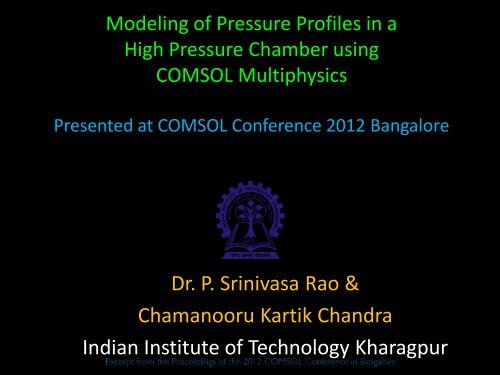
![[PDF] Microsoft Word - paper.docx - COMSOL.com](https://img.yumpu.com/50367802/1/184x260/pdf-microsoft-word-paperdocx-comsolcom.jpg?quality=85)
